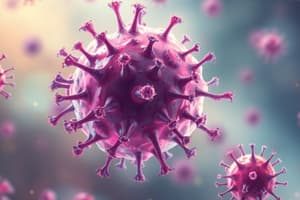Podcast
Questions and Answers
What is the diameter of the elementary bodies (EB)?
What is the diameter of the elementary bodies (EB)?
- 2-5 microns
- 0.5-2 microns
- 1-3 microns
- 0.2-0.3 microns (correct)
What is the reproductive form of Chlamydia?
What is the reproductive form of Chlamydia?
- Metabolic bodies
- Elementary bodies (EB)
- Reticular bodies (RB) (correct)
- Initial bodies
What is the shape of the elementary bodies (EB)?
What is the shape of the elementary bodies (EB)?
- Spherical (correct)
- Filamentous
- Rod-shaped
- Coccoid
What is the function of peptidoglycan in Chlamydia?
What is the function of peptidoglycan in Chlamydia?
Who discovered the presence of peptidoglycan in Chlamydia trachomatis?
Who discovered the presence of peptidoglycan in Chlamydia trachomatis?
What is the mode of reproduction in Reticular bodies (RB)?
What is the mode of reproduction in Reticular bodies (RB)?
What is the diameter of the Reticular bodies (RB)?
What is the diameter of the Reticular bodies (RB)?
What is the characteristic of the cell wall of Chlamydia?
What is the characteristic of the cell wall of Chlamydia?
What is the primary way that Chlamydia trachomatis obtains energy?
What is the primary way that Chlamydia trachomatis obtains energy?
What is the estimated number of people living in trachoma endemic areas?
What is the estimated number of people living in trachoma endemic areas?
What is the primary mode of transmission of trachoma?
What is the primary mode of transmission of trachoma?
What is the estimated percentage of global-level antibiotic coverage in 2018?
What is the estimated percentage of global-level antibiotic coverage in 2018?
What is the name of the strategy used to combat trachoma?
What is the name of the strategy used to combat trachoma?
What is the name of the condition that can develop in infants when infected with Chlamydia trachomatis?
What is the name of the condition that can develop in infants when infected with Chlamydia trachomatis?
What is the primary mode of transmission of genital chlamydiasis in men?
What is the primary mode of transmission of genital chlamydiasis in men?
What is the incubation period for men infected with genital chlamydiasis?
What is the incubation period for men infected with genital chlamydiasis?
What is the name of the disease caused by Rickettsia prowazekii?
What is the name of the disease caused by Rickettsia prowazekii?
What is the primary mode of transmission of Rickettsia?
What is the primary mode of transmission of Rickettsia?
What is the name of the disease caused by Chlamydia psittaci?
What is the name of the disease caused by Chlamydia psittaci?
What is the typical duration of symptoms in patients infected with Chlamydia psittaci?
What is the typical duration of symptoms in patients infected with Chlamydia psittaci?
What is the name of the syndrome caused by Chlamydia in men?
What is the name of the syndrome caused by Chlamydia in men?
What is the primary mode of transmission of Chlamydia psittaci?
What is the primary mode of transmission of Chlamydia psittaci?
What is the characteristic feature of Rickettsiae?
What is the characteristic feature of Rickettsiae?
What is the primary difference between Typhus and Typhoid?
What is the primary difference between Typhus and Typhoid?
Chlamydia is a type of extracellular pathogen.
Chlamydia is a type of extracellular pathogen.
The elementary bodies of Chlamydia are metabolically active.
The elementary bodies of Chlamydia are metabolically active.
Chlamydia has a cell wall that lacks peptidoglycan.
Chlamydia has a cell wall that lacks peptidoglycan.
Rickettsia is a type of gram-positive bacteria.
Rickettsia is a type of gram-positive bacteria.
Chlamydia can only infect epithelial cells.
Chlamydia can only infect epithelial cells.
Chlamydia is a motile bacterium.
Chlamydia is a motile bacterium.
Reticular bodies of Chlamydia can divide by binary fission.
Reticular bodies of Chlamydia can divide by binary fission.
The diameter of elementary bodies of Chlamydia is approximately 0.5-2 microns.
The diameter of elementary bodies of Chlamydia is approximately 0.5-2 microns.
Chlamydia trachomatis has a ATP-generating ability.
Chlamydia trachomatis has a ATP-generating ability.
Trachoma is a public health problem in only 20 countries.
Trachoma is a public health problem in only 20 countries.
Trachomatous scarring is caused by infection of conjunctival epithelial cells only.
Trachomatous scarring is caused by infection of conjunctival epithelial cells only.
Trachoma is typically found in cold, humid climates.
Trachoma is typically found in cold, humid climates.
Inclusion conjunctivitis is only found in neonatal form.
Inclusion conjunctivitis is only found in neonatal form.
The global-level antibiotic coverage in 2018 was 100%.
The global-level antibiotic coverage in 2018 was 100%.
Chlamydia can be transmitted through sexual contact and contaminated swimming pools.
Chlamydia can be transmitted through sexual contact and contaminated swimming pools.
The incubation period for men infected with genital chlamydiasis is typically less than 7 days.
The incubation period for men infected with genital chlamydiasis is typically less than 7 days.
Lymphogranuloma veneruum is a type of pneumonia caused by Chlamydia psittaci.
Lymphogranuloma veneruum is a type of pneumonia caused by Chlamydia psittaci.
Rickettsia can be transmitted through contaminated food and water.
Rickettsia can be transmitted through contaminated food and water.
Typhus is caused by Salmonella typhi.
Typhus is caused by Salmonella typhi.
The symptoms of psittacosis typically appear within 5 days of infection.
The symptoms of psittacosis typically appear within 5 days of infection.
Chlamydia trachomatis can cause epididymitis in women.
Chlamydia trachomatis can cause epididymitis in women.
Rickettsiae are facultative intracellular pathogens.
Rickettsiae are facultative intracellular pathogens.
Coxiella is transmitted through the bite of an infected arthropod.
Coxiella is transmitted through the bite of an infected arthropod.
Pediculus humanus corporis is the vector responsible for transmitting Typhoid fever.
Pediculus humanus corporis is the vector responsible for transmitting Typhoid fever.
Study Notes
Chlamydia and Rickettsia: Intracellular Lifestyle
Chlamydia
- Family: Chlamydia (previously included 2 genera: Chlamydia and Chlamydophila)
- Species:
- C. trachomatis: ocular, genital
- C. psittaci: psittacosis
- C. pneumoniae: 10-20% of community-acquired pneumonia (CAP), cardiovascular disease
- Obligate intracellular pathogens: non-motile, coccoid bacilli that inhabit epithelial cells/macrophages
- Elementary bodies (EB): infectious form, metabolically inactive, electron dense, nucleoid, granular cytoplasm, spherical, approximately 0.2-0.3 microns in diameter
- Reticular bodies (RB): intracellular reproductive form, metabolically active, chromatin dispersed, approximately 0.5-2 microns in diameter, can divide by binary fission
- Energy parasites: lack ATP-generating ability, must obtain from host cell
Chlamydia Trachomatis
- Most common preventable cause of blindness: public health problem in 44 countries, responsible for blindness or visual impairment of about 1.9 million people
- Trachoma: infection of conjunctival epithelial cells, repeated clinical/subclinical infection and cell infiltration can cause cornea to cloud/scar
- SAFE strategy: Surgery, Antibiotics, Facial cleanliness, and Environmental improvement
- Inclusion conjunctivitis: neonatal form, adult form (STD, swimming pools)
- Genital chlamydiasis: urethritis, cervicitis, PID, infertility, ectopic pregnancy, premature delivery, postpartum fever, LGV
Chlamydia Psittaci
- Psittacosis/parrot fever: isolated from over 100 avian species, especially cockatiels and parakeets
- EB very resistant: can survive in feed for 2 months
- Clinical signs: range from non-apparent to flu-like to severe pneumonia (30-60 year olds)
- Risk groups: occupational disease, pigeon farmers, pet shop owners, veterinarians, poultry workers
Rickettsia
General Features
- Obligate intracellular pathogens: small coccoids or rods (0.3 by 1-2 microns)
- Fastidious: require embryonic eggs, tissue culture cells
- Structurally similar to Gram-negative bacteria: LPS and PG cell walls
- Multiply by binary fission: only in infected cells
- Transmitted by arthropod vectors: except Coxiella (Q fever)
Typhus
- Caused by Rickettsia prowazekii: arrives in Europe in 1489 via soldiers returning from Cyprus
- Transmitted by Pediculus humanus corporis: infected faeces
- Incubation: 7-14 days, high fever, chills, headache, may lead to coma
- Macular eruption: 5-6 days after onset
Typhus vs Typhoid
- Typhus: cough, headache, joint and muscle pain, nausea, chills, confusion, low blood pressure
- Typhoid: abdominal tenderness, agitation, bloody stool, chills, confusion, delirium, hallucinations, nose bleeds, and fatigue
Chlamydia and Rickettsia: Intracellular Lifestyle
Chlamydia
- Family: Chlamydia (previously included 2 genera: Chlamydia and Chlamydophila)
- Species:
- C. trachomatis: ocular, genital
- C. psittaci: psittacosis
- C. pneumoniae: 10-20% of community-acquired pneumonia (CAP), cardiovascular disease
- Obligate intracellular pathogens: non-motile, coccoid bacilli that inhabit epithelial cells/macrophages
- Elementary bodies (EB): infectious form, metabolically inactive, electron dense, nucleoid, granular cytoplasm, spherical, approximately 0.2-0.3 microns in diameter
- Reticular bodies (RB): intracellular reproductive form, metabolically active, chromatin dispersed, approximately 0.5-2 microns in diameter, can divide by binary fission
- Energy parasites: lack ATP-generating ability, must obtain from host cell
Chlamydia Trachomatis
- Most common preventable cause of blindness: public health problem in 44 countries, responsible for blindness or visual impairment of about 1.9 million people
- Trachoma: infection of conjunctival epithelial cells, repeated clinical/subclinical infection and cell infiltration can cause cornea to cloud/scar
- SAFE strategy: Surgery, Antibiotics, Facial cleanliness, and Environmental improvement
- Inclusion conjunctivitis: neonatal form, adult form (STD, swimming pools)
- Genital chlamydiasis: urethritis, cervicitis, PID, infertility, ectopic pregnancy, premature delivery, postpartum fever, LGV
Chlamydia Psittaci
- Psittacosis/parrot fever: isolated from over 100 avian species, especially cockatiels and parakeets
- EB very resistant: can survive in feed for 2 months
- Clinical signs: range from non-apparent to flu-like to severe pneumonia (30-60 year olds)
- Risk groups: occupational disease, pigeon farmers, pet shop owners, veterinarians, poultry workers
Rickettsia
General Features
- Obligate intracellular pathogens: small coccoids or rods (0.3 by 1-2 microns)
- Fastidious: require embryonic eggs, tissue culture cells
- Structurally similar to Gram-negative bacteria: LPS and PG cell walls
- Multiply by binary fission: only in infected cells
- Transmitted by arthropod vectors: except Coxiella (Q fever)
Typhus
- Caused by Rickettsia prowazekii: arrives in Europe in 1489 via soldiers returning from Cyprus
- Transmitted by Pediculus humanus corporis: infected faeces
- Incubation: 7-14 days, high fever, chills, headache, may lead to coma
- Macular eruption: 5-6 days after onset
Typhus vs Typhoid
- Typhus: cough, headache, joint and muscle pain, nausea, chills, confusion, low blood pressure
- Typhoid: abdominal tenderness, agitation, bloody stool, chills, confusion, delirium, hallucinations, nose bleeds, and fatigue
Studying That Suits You
Use AI to generate personalized quizzes and flashcards to suit your learning preferences.
Related Documents
Description
Learn about the impact and aetiology of Chlamydia and Rickettsia, including their unique life cycle and intracellular survival. Understand the characteristics of these bacteria and their effects on human health.




